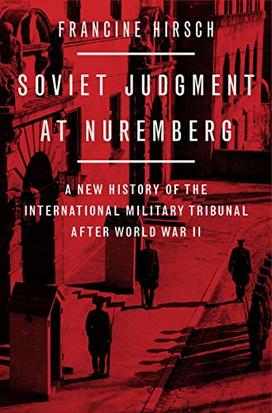Francine Hirsch *98 Writes First Account of Soviet Contributions in Nuremberg Trials

Soviet Judgment at Nuremberg: A New History of the International Military Tribunal after World War II (Oxford University Press) includes research from previously unavailable sources to take a new look at Nuremberg. Hirsch offers a fuller picture of the ways politics and international law intertwine, and suggests that Soviet conceptions of postwar justice and war as seen at Nuremberg have found a permanent place in international law.
The author: Francine Hirsch *98 is Vilas Distinguished Achievement Professor of History at the University of Wisconsin-Madison, where she teaches Soviet and modern European history. Her first book, Empire of Nations: Ethnographic Knowledge and the Making of the Soviet Union (2005), received several prizes, including the Herbert Baxter Adams Prize of the American Historical Association.

Nuremberg was rich with symbolic significance. The city had been the cradle of the Nazi movement, the site of choreographed mass rallies — recorded for posterity in Leni Riefenstahl’s Triumph of the Will — at which Adolf Hitler had announced the Third Reich’s race laws and roused millions of followers with the promise of a resurgent Germany. It had also been one of the last holdouts of German forces, the setting of one of the final battles of the war in Europe. This was a fitting place for a postwar reckoning.
Among those who came to observe the trial was the Soviet filmmaker Roman Karmen, a special correspondent for the Soviet press who was tasked with documenting the proceedings. Making his way through the city in a car on the day of his arrival, Karmen was struck by the devastation. “You do not see one intact structure in Nuremberg,” he observed. “It is sheer ruins.” Karmen had spent the last few years as a cameraman embedded with the Red Army, shooting footage in Leningrad, on the Don, and on the Belorussian front. He had seen what war could do. Even so, he was taken aback by what he now encountered. Nuremberg had been nearly leveled by repeated Allied bombing campaigns and street-to-street fighting. The medieval town center as well as the more modern parts of the city had been reduced to piles of rubble and debris. Before leaving Moscow, Karmen had watched German newsreels and documentary films showing the city in its glory days under the Nazis. He recalled scenes of extraordinary splendor, the Nazi Party Rally Grounds, and the endless parades of SS units, Hitler Youth, and soldiers. It seemed impossible to believe that this was the same city.
Review: “Fifteen years in the making, drawing extensively on Soviet archives, Francine Hirsch’s wonderful book freshly illuminates the paradoxical Soviet impact on the trial of Nazi criminals as well as the inner working of the Kremlin as it navigated the onset of the Cold War.” — William Taubman, Pulitzer Prize-winning author of Khrushchev: the Man and His Era and Gorbachev: His Life and Times











No responses yet